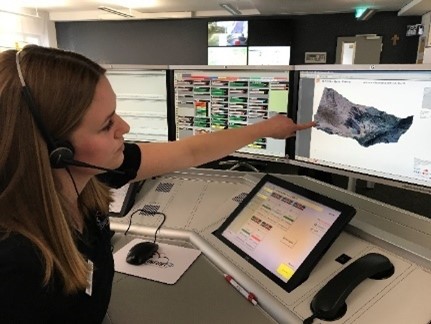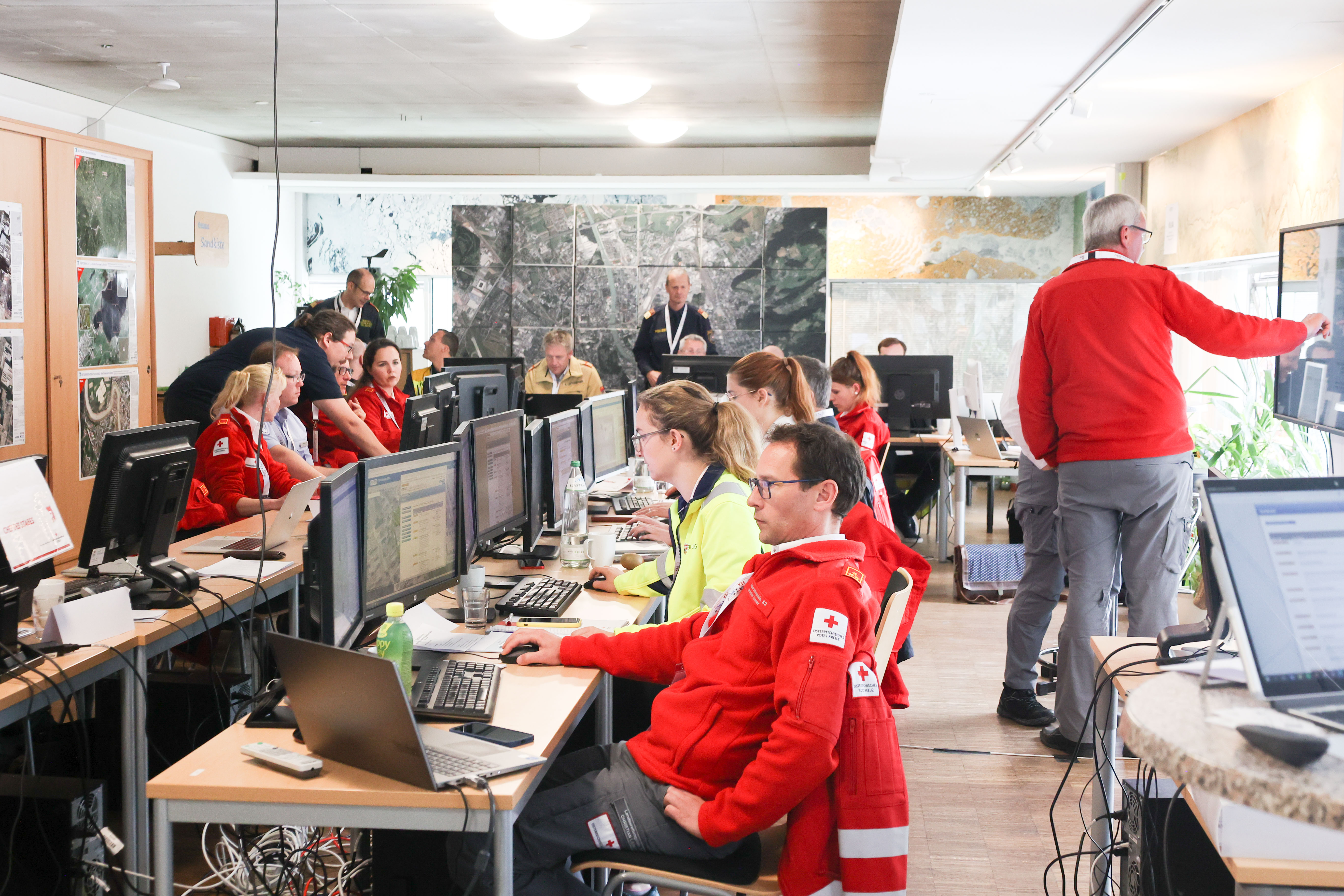Leadership and Command in Emergency Operations: The German Regulation DV 100 (Dienstvorschrift 100)

12 February 2024
Margareta Mihalic Dogan, BRK HQ
Uwe Kippnich, BRK HQ
Martin Ibrom, BRK Civil Protection
Introduction: Why we need it
A strong leadership and command systems are crucial for success in large scale emergency management situations, such as floodings, storms and similar events. These systems form the core of coordinated efforts during crises, offering a framework for managing information, organising teams, and ensuring consistent communication among Public Protection and Disaster Relief (PPDR) agencies. They are essential because they help streamline procedures, maintain high standards, and follow established protocols when dealing with emergencies, no matter their size or difficulty. This structure also provides a point of contact for the command post in the field and other involved parties.
Information Management and Structure Organisation
The Leadership and Command in Emergency Operations Guideline (Ger. “Dienstvorschrift” DV 100) primarily outlines and regulates leadership and command structures in emergency situations. The document provides a clear and German-wide accepted structure on how emergency operations should be managed, including aspects related to leadership roles, decision-making, coordination, and communication among emergency response teams during crises or disasters. Its aim is to ensure effective management and coordination to handle emergency situations efficiently and safeguard lives and property.
In emergency operations, managing information is key for an efficient disaster management. A well-structured command system helps share important information quickly between different agencies involved. Structuring information uniforms communication and comprehension, ensuring harmonised collaboration, particularly in challenging circumstances. It also sets a high standard for how to respond in emergencies, reducing mistakes and confusion during crisis management. The benefit of this system is that all partners are working by the same regulation and have the same understanding.
By addressing key elements such as command structure, information management, resource allocation, coordination, training, and evaluation, DV100 aims to establish a robust and adaptable system that can effectively manage various crisis scenarios.
Activation of the System
The DV 100 system gets put into action if the “normal” incident escalates up to the disaster. When an event needs ongoing attention for over 5 to 8 hours, it triggers a careful evaluation, and the structured command system gets activated. In that case there is a need to build own control room. For this purpose, a large lecture room will be used, located at a fire or rescue station. It is necessary that the room is equipped with infrastructure such as internet connection, communication systems via phone, that it has access to an emergency broadcasting system for public warnings, and, if possible, to satellite connection and digital radio communication. The information and communication team will set up the structure with IT-network, workstations, flip carts, beamers and more. When many are involved in managing the disaster, it requires understanding how different PPDR groups can work together, as well as on different levels between local branches and the next higher department, like, for example, district government. The system makes it easier for involved agencies to join forces, using their expertise and resources together for a united response.
Internal Structure
In DV100, the internal structure of the command system is divided into six core staff sections (Ger. Sachgebiete) that are labelled S1-S6, which describe roles and duties. The system is flexible, so it can change in size or scope as the crisis develops.
At the helm of the system is the Incident Commander, with the responsibility of overseeing and orchestrating the emergency response in the command post. Their primary task is to make crucial decisions and provide strategic directives for efficiently addressing the emergency.
Supporting the Incident Commander are diverse specialised roles. The S1 covers Personnel and Administration and is responsible for the operation-room works, S2 is Information Gathering and assessment, S3 is Operations with the task of creating a plan of action, designed to achieve a series of objectives or a particular goal in the light of the assessed risks. S3 is also responsible for the deployment of personnel and equipment to the incident ground based on a strategic plan. The S4 manages the logistics. If the situation requires, additional functions might be established through roles S5 (Media and Press) and S6 (Communications and Transmissions). All the positions will be occupied by the personnel specifically trained for the task. The leader of the emergency room is a highly trained commander with an extensive experience in disaster management.
Effective communication and teamwork among these roles constitute integral components of the Command-and-Control Structures. Facilitating clear and expeditious information sharing among team members is imperative for informed decision-making and the efficient execution of tasks during emergency situations.

Figure 1: The incident command staff. Source: DV100
Experience from Former Disasters
The German command system during emergencies has proven its success in many situations. It's been used in big sports events, heavy snowstorms, and floods. One good example was how well it worked during the flash flood in Summer 2021 in Western Europe focused on Ahrtal (Ahr Valley), close to the city Cologne, in Germany. It showed that the system can adapt and stay strong when dealing with large scale disasters. The Summer 2021 flood affected a lot of countries, federal states, and states. In this case it was useful to exchange the results of the assessment and the plan of action. The continuous process of situation assessment and necessary readjustments are also a benefit.
An important part, especially for administrators, revolves around documentation. Upon the completion of operations, it is frequently noted that the standardised system in accordance with DV 100, coupled with corresponding documentation of situations and measures, emerges as an effective tool for diverse administrative post-processing responsibilities, encompassing financial matters. Additionally, its indispensability in potential legal disputes cannot be overstated.

Figure 2: Operation centre. Source: Land Salzburg/ Franz Neumayer
To maximise the effectiveness of the tool, it is crucial to decide on activation and implementation of the system promptly in case of incidents. This proactive approach helps preventing the development of counterproductive parallel structures. Despite the existence of a standardised system, the design remains flexible and can always be adjusted to fit the specific situation. This involves incorporating diverse expert advice and utilising pre-command or assessment tools. Consequently, despite the appearance of strict guidelines, there is significant flexibility in the designing process.
Implementing the System in TEMA Trials
Utilising the German command system DV100 in the TEMA pilot trials offers a valuable opportunity to simulate real-life scenarios. By using digital twins real missions, it facilitates the seamless integration of the TEMA solution into the existing structure. The emphasis is on the internal structure, specifically roles S2 (information gathering/assessment) and S3 (operations), providing a robust foundation. Specialized staff, trained in this mechanism, will be stationed in these functions, and same implementation will extend to the emergency room. This setting also provides the space and understanding to evaluate new tools and technologies integrated into TEMA solutions, as well as methods, and procedures. TEMA pilot trials will serve as tests to verify the efficacy of TEMA solution within the organised command system under simulated real conditions.
Benefit and Lessons Learned
The use of a standard system among all PPDR groups is a great advantage. We keep learning from past experiences in managing response in disasters, making the system better and able to handle new challenges. This way of working gives the opportunity to make quick changes when emergencies get more complicated.
To sum up, leadership and command structures are of great importance when handling the emergencies. The DV100 has proven itself through different disasters and it was used by all PPDR, showing it is a good example to follow. Bringing this system into TEMA trials will not only makes it efficient, but also will helps handling emergencies more efficient, keeping communities safe.
Bibliography:
[1] DV 100 Leadership and Command in Emergency Operations. Available at: https://www.bavfc.org/wp-content/uploads/2018/05/feuerwehrportal_FwDV100-EN_2007-09.pdf
[2] Cover photo - Source: BRK

